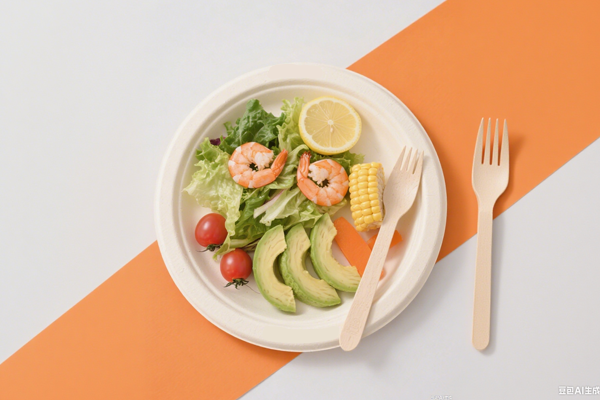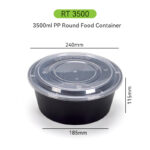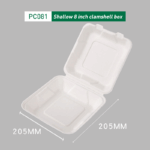Disposable bagasse products are gaining worldwide attention as eco-friendly alternatives to plastic and styrofoam. Yet, despite their rapid growth in the foodservice and retail industries, misconceptions remain widespread. Some assume bagasse is too expensive, while others doubt its durability or compostability.
In this article, we’ll break down the 8 most common myths about bagasse disposables, explain the reality with scientific data and real-world examples, and show why these products are key to a more sustainable future.
What Exactly Are Bagasse Products?
Bagasse is the fibrous byproduct left over after extracting juice from sugarcane. Instead of discarding or burning this material, manufacturers mold it into plates, clamshell take-out boxes, bowls, trays, and even coffee cups.
This process transforms agricultural waste into something useful, lowering reliance on petroleum-based plastics. Bagasse products are:
-
Renewable – derived from sugarcane crops.
-
Compostable – can break down in 60–90 days under proper conditions.
-
Durable – strong enough for hot, cold, and greasy foods.
No wonder global demand for bagasse disposables is booming in both commercial and household markets.

Myth 1: Bagasse Products Are Too Expensive
Explanation: Many people believe eco-friendly equals costly, assuming that switching from plastic to bagasse will hurt profit margins.
Reality: While bagasse sometimes carries a slightly higher unit cost, the overall economics are favorable:
-
Falling Prices: With rising demand and scaled-up production, prices have become competitive with traditional disposables.
-
Brand Value: Restaurants and cafés that use eco-packaging often enjoy stronger brand loyalty and can charge premium menu prices.
-
Waste Savings: Bagasse reduces landfill costs and aligns with municipal composting systems, lowering disposal fees.
👉 Over time, the small upfront difference is outweighed by long-term financial and reputational gains.
Myth 2: Bagasse Is Weak and Breaks Easily
Explanation: Because bagasse is plant-based, some assume it lacks strength compared to plastic.
Reality: In fact, bagasse is remarkably sturdy. Its fibrous structure provides high tensile strength, allowing products to:
-
Carry heavy meals without bending.
-
Resist leaks when serving greasy or saucy foods.
-
Maintain shape with hot soups or cold desserts.
Studies show bagasse containers can handle temperatures up to 200°F (93°C), making them microwave-safe and oven-friendly for short reheating.
Myth 3: Bagasse Isn’t Truly Eco-Friendly
Explanation: Skeptics worry that producing bagasse items consumes too much energy or that they won’t really break down.
Reality: Bagasse is considered one of the most sustainable disposable materials:
-
Byproduct Use: It repurposes sugarcane waste that would otherwise be burned, lowering carbon emissions.
-
Low-Impact Production: Requires less energy than petroleum-based plastics.
-
Rapid Decomposition: Breaks down within months, unlike plastics that persist for centuries.
👉 For best results, buyers should choose products with compostable certifications like EN13432 or ASTM D6400.
Myth 4: Bagasse Products Are Hard to Find
Explanation: Some assume bagasse products are niche, only available through specialty suppliers.
Reality: The opposite is true. Today, bagasse disposables are widely available:
-
Online: Amazon, eco-retail sites, and wholesale distributors.
-
Retail: Grocery stores and eco-friendly shops.
-
B2B Supply: Foodservice distributors now offer bagasse alongside plastics.
The global market for bagasse packaging is growing at a double-digit rate, making sourcing easier than ever.
Myth 5: Bagasse Can’t Handle Hot or Cold Foods
Explanation: People worry bagasse is only good for room-temperature meals.
Reality: Bagasse performs across temperature extremes:
-
Hot Foods: Soup, curries, coffee, and noodles are safe without leaks or softening.
-
Cold Foods: Ice cream, salads, and chilled drinks don’t compromise structure.
-
Greasy Foods: Fibers resist oil absorption, preventing sogginess.
This versatility makes bagasse ideal for restaurants, catering services, and household use.
Myth 6: Bagasse Takes Forever to Decompose
Explanation: There’s skepticism about whether bagasse really composts as quickly as advertised.
Reality: Bagasse breaks down much faster than plastic or coated paper:
-
Industrial Composting: 60–90 days to fully decompose.
-
Home Composting: A few months, depending on conditions.
-
Landfills: Even in low-oxygen environments, decomposition occurs in years, not centuries.
👉 This rapid breakdown reduces landfill load and supports circular economy practices.
Myth 7: Bagasse Is Only for Restaurants and Cafés
Explanation: Many think bagasse is exclusive to commercial foodservice.
Reality: Bagasse is versatile and widely used in households:
-
Events: Weddings, birthdays, and outdoor parties.
-
Picnics: Lightweight and easy to carry.
-
Everyday Home Use: A sustainable alternative to disposable plastics.
With growing retail presence, families can buy bagasse disposables for daily convenience without environmental guilt.
Myth 8: Bagasse Requires Special Disposal Methods
Explanation: Some believe bagasse needs specialized facilities to compost properly.
Reality: While industrial composting accelerates the process, bagasse can decompose in home compost bins too. Even if mistakenly landfilled, it will still degrade significantly faster than petroleum-based plastics.
👉 Unlike PLA (corn-based bioplastic), bagasse doesn’t require high heat or controlled environments to break down—making it more practical for everyday users.
FAQ About Bagasse Products
Q1: Are bagasse products safe for microwaves and ovens?
Yes, most are microwave-safe and can handle oven reheating under moderate heat.
Q2: How do bagasse and PLA disposables compare?
Bagasse composts more easily in both home and industrial setups, while PLA usually requires specialized facilities.
Q3: Can bagasse completely replace plastic?
Not yet for every use case (e.g., liquids stored long-term), but it already covers most foodservice packaging needs.
Conclusion
Bagasse products aren’t a passing trend—they are an essential step toward a sustainable packaging future. By addressing misconceptions, we can see that bagasse is:
-
Affordable in the long run
-
Durable enough for any food type
-
Readily available worldwide
-
Genuinely eco-friendly and compostable
For households, restaurants, and foodservice chains alike, switching to bagasse helps reduce plastic pollution and supports the global shift to greener lifestyles.

References
-
U.S. Environmental Protection Agency (EPA) – Composting Basics
https://www.epa.gov/recycle/composting-home -
European Bioplastics – Biodegradable and Compostable Plastics Facts
https://www.european-bioplastics.org/bioplastics/ -
National Renewable Energy Laboratory (NREL) – Biomass Applications in Packaging
https://www.nrel.gov -
Composting Council – Home vs. Industrial Composting Guidelines
https://www.compostingcouncil.org
Disclaimer & Copyright Notice
This article is created by the Dashan Packing editorial and research team.All information presented here is for educational and industry reference purposes only.Some data and standards cited in this article are sourced from publicly available materials,official regulatory documents, or third-party publications, which are properly credited where applicable.
All rights to third-party trademarks, images, and content belong to their respective owners.If any copyrighted material has been used inadvertently, please contact us at angel@chndashan.com.We respect intellectual property rights and will promptly remove or revise any material upon verification.





